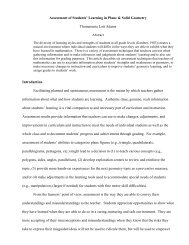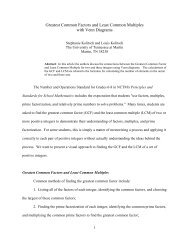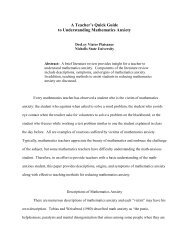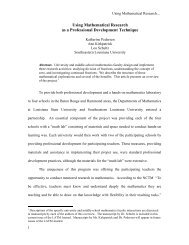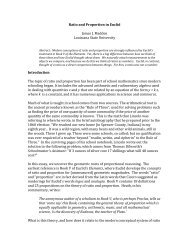the number line - Louisiana Association of Teachers of Mathematics
the number line - Louisiana Association of Teachers of Mathematics
the number line - Louisiana Association of Teachers of Mathematics
- No tags were found...
You also want an ePaper? Increase the reach of your titles
YUMPU automatically turns print PDFs into web optimized ePapers that Google loves.
TEACHING MATHEMATICSA Brief Look at Ma<strong>the</strong>matics AnxietyDesLey Viator Plaisance, Ph.D.Nicholls State UniversityGrade-level expectations. Comprehensive Curriculum. Common Core State Standards. All aredocuments providing some guide for teaching ma<strong>the</strong>matics. All provide teachers with activitiesand ideas to use in <strong>the</strong> ma<strong>the</strong>matics classroom. But, no matter what “guide” is given toteachers, <strong>the</strong>re are students who fear ma<strong>the</strong>matics and that fear – known as math anxiety –must be addressed.Sheila Tobias, author <strong>of</strong> Overcoming Math Anxiety, referred to math anxiety as “<strong>the</strong> panic,helplessness, paralysis and mental disorganization that arises among some people when <strong>the</strong>yare required to solve a ma<strong>the</strong>matical problem” (Tobias and Weissbrod, 1980, p. 65). Reys,Lindquist, Lambdin, and Smith (2007) (authors <strong>of</strong> a math methods textbook) depict mathanxiety as a gorge that separates <strong>the</strong> “concrete” from <strong>the</strong> “abstract.” That gorge is described ashaving challenging ma<strong>the</strong>matics classroom behaviors including not liking math, not havingconfidence, lacking self-motivation, and having poor test-taking skills.There are some suggested teaching techniques that assist students in reducing <strong>the</strong>ir fear <strong>of</strong>ma<strong>the</strong>matics and <strong>the</strong>reby decreasing <strong>the</strong>ir level <strong>of</strong> ma<strong>the</strong>matics anxiety. If ma<strong>the</strong>maticsteachers are to take students on a successful journey from <strong>the</strong> “concrete” to <strong>the</strong> “abstract,” <strong>the</strong>nteachers must provide appropriate activities and adequate time for students to cross that gorge.Conceptual understanding should be encouraged along with memorizing needed facts in thatstudents “attempting to memorize ma<strong>the</strong>matics without understanding are likely to fall into this‘anxiety gorge’” (Reys et al., 2007, pl. 18). Appropriate activities should include modelingrepresentation which allows students to learn methods for representing ma<strong>the</strong>matical ideas inbasic ways such as sketches and word equations prior to introduction <strong>of</strong> symbolic representation.<strong>Teachers</strong> should guide <strong>the</strong>ir students over <strong>the</strong> gorge by helping <strong>the</strong>m make <strong>the</strong> connectionsbetween <strong>the</strong> concrete and <strong>the</strong> abstract through promoting conceptual understanding whileincreasing successful learning and decreasing ma<strong>the</strong>matics anxiety.The National Council <strong>of</strong> Ma<strong>the</strong>matics (NCTM) (1995a) suggests various teaching strategies todecrease and prevent students’ ma<strong>the</strong>matics anxiety. Most <strong>of</strong> <strong>the</strong>se strategies are used byteachers in that <strong>the</strong>y are considered “best teaching practices.” The recommended strategies areas follows:1. Accommodate different styles <strong>of</strong> learning;2. Create a variety <strong>of</strong> testing environments;3. Design positive experiences;4. Emphasize that ma<strong>the</strong>matical ability is not a measure <strong>of</strong> self-worth;5. Emphasize that everyone makes mistakes in ma<strong>the</strong>matics;6. Make ma<strong>the</strong>matics relevant to life;7. Allow students input into <strong>the</strong>ir own evaluations;8. Allow for different social approaches to learning ma<strong>the</strong>matics;9. Encourage original thinking instead <strong>of</strong> rote memorization;10.Characterize ma<strong>the</strong>matics as a human endeavor.Hembree (1990) indicated that when teaching strategies such as <strong>the</strong>se are implemented in <strong>the</strong>classroom, <strong>the</strong> level <strong>of</strong> student ma<strong>the</strong>matics anxiety is usually reduced.In conclusion, teachers should always be alert to <strong>the</strong> needs <strong>of</strong> <strong>the</strong>ir students and try to meet asmany <strong>of</strong> <strong>the</strong>se needs as possible. If students show any signs <strong>of</strong> having math anxiety, teachersshould remember <strong>the</strong> recommended teaching strategies. It is believed that teachers are <strong>the</strong>The Number Line ∞ January 2012 14



